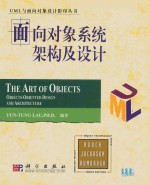图书介绍
面向对象系统架构及设计 the art of objects object oriented design and architecture【2025|PDF下载-Epub版本|mobi电子书|kindle百度云盘下载】

- 著
- 出版社:
- ISBN:
- 出版时间:未知
- 标注页数:0页
- 文件大小:51MB
- 文件页数:377页
- 主题词:
PDF下载
下载说明
面向对象系统架构及设计 the art of objects object oriented design and architecturePDF格式电子书版下载
下载的文件为RAR压缩包。需要使用解压软件进行解压得到PDF格式图书。建议使用BT下载工具Free Download Manager进行下载,简称FDM(免费,没有广告,支持多平台)。本站资源全部打包为BT种子。所以需要使用专业的BT下载软件进行下载。如BitComet qBittorrent uTorrent等BT下载工具。迅雷目前由于本站不是热门资源。不推荐使用!后期资源热门了。安装了迅雷也可以迅雷进行下载!
(文件页数 要大于 标注页数,上中下等多册电子书除外)
注意:本站所有压缩包均有解压码: 点击下载压缩包解压工具
图书目录
CHAPTER 1 Basic Concepts1
1.1 The Nature of Objects1
1.2 Unified Modeling Language3
1.3 UML Notation Basics4
1.4 Object Creation and Destruction6
1.5 Associations and Links7
1.5.1 Binary Associations and Links8
1.5.2 Ordering and Sorting9
1.5.3 Navigation and Referential Integrity10
1.5.4 Ternary and Higher Order Associations11
1.6 Aggregation and Composition13
1.7 Servant Classes and Delegation14
1.8 Inheritance15
1.8.1 Inherited versus Servant Classes16
1.8.2 Polymorphism and Object Substitution17
1.9 Exercises19
CHAPTER 2 Common Patterns in Static Design21
2.1 Collection Managers21
2.2 Containers23
2.3 Self-Containing Classes,Hierarchies,and Networks24
2.4 Relationship Loops26
2.4.1 Relationship Fission30
2.4.2 Inheritance of Relationship Loops31
2.4.3 Double Loops32
2.4.4 Three-Tier Relationship Loops32
2.5 Binary Association Classes33
2.5.1 Implementing Binary Association Classes36
2.5.2 Recursive Association Class38
2.6 The Handle-Body Pattern39
2.7 Dynamic Schema40
2.8 Shared Object Pools41
2.9 Object Model for Extensible Markup Language43
2.9.1 XML Basics44
2.9.2 XML Object Models46
2.9.3 The Strengths and Weaknesses of XML48
2.10 Case Study:ATM System Software—Part 149
2.10.1 Project Description49
2.10.2 State Analysis and Design50
2.11 Case Study:Shared Whiteboard—Part 153
2.12 Case Study:Access Control Lists—Part 161
2.13 Exercises63
CHAPTER 3 Persistent Objects69
3.1 Transactions and Database Management Systems70
3.2 Object-Oriented Databases71
3.2.1 Database Roots and Extents72
3.2.2 Persistence-Enabled Objects74
3.2.3 Destruction of Persistent Objects75
3.2.4 Schema Evolution76
3.3 Relational Databases76
3.4 Mapping Persistent Objects to Tables77
3.4.1 Classes and Binary Associations78
3.4.2 Aggregation,Composition,and Servant Classes80
3.4.3 Ternary and Higher Order Associations81
3.4.4 Reducing Ternary Associations to Binary Ones82
3.4.5 Degenerate Ternary Associations85
3.4.6 Inheritance88
3.4.7 Mapping Rules Summary90
3.5 A Critical Comparison Between Relational and Object-Oriented Databases91
3.5.1 Optimization of Relational Tables93
3.5.2 Optimization of Persistent Objects95
3.6 Case Study:ATM System Software—Part 297
3.7 Case Study:Shared Whiteboard—Part 297
3.8 Case Study:A Rental Business—Part 198
3.8.1 Initial Analysis and Design98
3.8.2 Full Object Design for Multiple Stores101
3.8.3 Detailed Object Designs101
3.9 Case Study:Access Control Lists—Part 2110
3.10 Exercises116
CHAPTER 4 Advanced Topics in Object Modeling125
4.1 Abstract Classes125
4.2 Multiple Inheritance126
4.3 Interfaces128
4.4 Inner Classes129
4.5 Collections130
4.6 Packages131
4.7 Components132
4.8 Nodes133
4.9 UML Notation Basics for Dynamic Modeling134
4.10 Reverse Engineering and Irreducible Patterns135
4.11 Exercises137
CHAPTER 5 Dynamic Object Modeling Basics139
5.1 Use Case Analyses139
5.2 Sequence Diagrams141
5.3 The Client/Server Model and Distributed Objects144
5.4 Interface Definition and Client/Server Development146
5.5 The CORBA Standard148
5.6 Interface Definition Language150
5.7 Statechart Diagrams154
5.8 Case Study:ATM System Software—Part 3156
5.9 Case Study:Shared Whiteboard—Part 3159
5.10 Case Study:A Rental Business—Part 2162
5.11 Case Study:Access Control Lists—Part 3165
5.12 Exercises166
CHAPTER 6 Common Interface Design Patterns169
6.1 Object Wrappers169
6.2 Object Adapters171
6.3 Object Factories and Managers172
6.4 Interfaces as Servant Classes173
6.5 Servant Interfaces in Event Processing175
6.5.1 Single Event Pushing and Observers176
6.S.2 Callbacks from Server Objects177
6.5.3 Subscription and Notification177
6.5.4 Model-View-Controller180
6.6 Relationship Loops with Interfaces182
6.7 Inheritance Ladders183
6.8 CORBA Objects183
6.9 CORBA Client Stubs188
6.10 Tactics in Designing Distributed Objects189
6.11 Proxy and Surrogate Objects191
6.12 Case Study:ATM System Software—Part 4192
6.13 Case Study:Shared Whiteboard—Part 4197
6.13.1 Message Port—An Infrastructure for a Collaboration Group197
6.13.2 Sequence Diagrams for MessagePort201
6.14 Case Study:Access Control Lists—Part 4203
6.15 Exercises204
CHAPTER 7 Object-Oriented Architecture207
7.1 Notations for Architecture Diagrams208
7.2 Procedural Processing Systems209
7.3 Client/Server Systems211
7.3.1 "Thin Clients" and Object IDs213
7.3.2 Web Applications Using the MVC Framework215
7.4 Layered Systems217
7.4.1 Layering with Servant Objects219
7.5 Three-Tier and Multi-Tier Systems221
7.5.1 Clustering and Serializing223
7.6 Agents226
7.7 Aggregations and Federations228
7.8 Architectural Patterns in UML230
7.9 Case Study:ATM System Software—Part 5233
7.10 Case Study:Shared Whiteboard—Part 5236
7.10.1 The Shared Whiteboard Aggregation236
7.10.2 Image Exchange Formats and Policies237
7.10.3 The Interface and Control Layers240
7.10.4 Synchronization and Related Issues244
7.10.5 Trace Table for Requirements246
7.11 Case Study:A Rental Business—Part 3247
7.12 Case Study:The Enterprise JavaBeans Framework249
7.12.1 Static Structures249
7.12.2 Resource Management Strategies253
7.12.3 Dynamic Behaviors of Entity Beans254
7.13 Exercises258
CHAPTER 8 Summaries and Notes259
8.1 Chapter 1 Summary and Notes259
8.2 Chapter 2 Summary and Notes260
8.3 Chapter 3 Summary and Notes261
8.4 Chapter 4 Summary and Notes262
8.5 Chapter 5 Summary and Notes263
8.5.1 Notes on CORBA-COM Interoperability264
8.6 Chapter 6 Summary and Notes264
8.7 Chapter 7 Summary and Notes265
8.8 Case Studies Summary266
CHAPTER 9 Answers to Exercises269
9.1 Chapter 1 Exercise Answers269
9.2 Chapter 2 Exercise Answers274
9.3 Chapter 3 Exercise Answers294
9.4 Chapter 4 Exercise Answers310
9.5 Chapter 5 Exercise Answers313
9.6 Chapter 6 Exercise Answers318
9.7 Chapter 7 Exercise Answers328
APPENDIX A Quick References for Object Designers341
APPENDIX B Sample Code Reference List347
APPENDIX C Features of Object-Oriented Languages351
References353
Index357
热门推荐
- 115020.html
- 284688.html
- 1148174.html
- 1797683.html
- 1506417.html
- 2961327.html
- 1792897.html
- 1307551.html
- 579382.html
- 1365752.html
- http://www.ickdjs.cc/book_1880174.html
- http://www.ickdjs.cc/book_3877926.html
- http://www.ickdjs.cc/book_1994619.html
- http://www.ickdjs.cc/book_1993232.html
- http://www.ickdjs.cc/book_1632913.html
- http://www.ickdjs.cc/book_2951402.html
- http://www.ickdjs.cc/book_2953219.html
- http://www.ickdjs.cc/book_463292.html
- http://www.ickdjs.cc/book_3737110.html
- http://www.ickdjs.cc/book_3814970.html